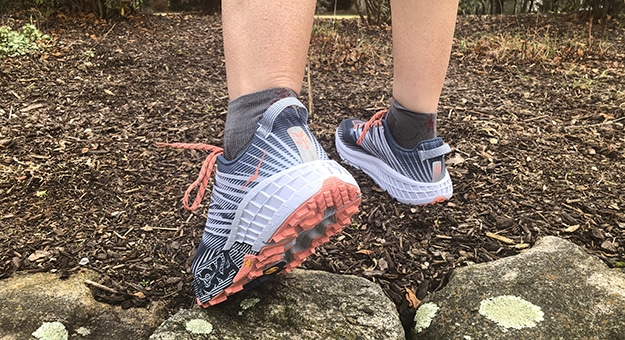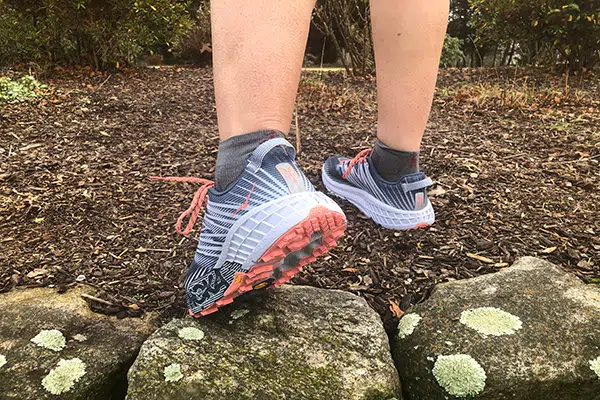My HOKA One One Challenger ATR 5 vs. Speedgoat 4 initial impressions are below. Ultimately, I decided on the Challenger ATR 5’s instead of the Speedgoat 4’s, but by the end of the Colorado Trail, I had switched from my Challenger ATR 5’s to the HOKA One One EVO Speedgoat.
The trail runner I’m using now is the HOKA One One Speedgoat 5.
My trail runners change almost every year since the styles change yearly. For example, I used HOKA Challengers on the Colorado Trail before switching to HOKA EVOs.
HOKA then discontinued the EVOs but incorporated some features into the Speedgoat 5s. I tried the HOKA Mafates on the Arizona Trail this year and then switched to the HOKA Speedgoat 5’s when I finished the AZT and came home.
I purchased five pairs of the HOKA Speedgoat 5 Trailrunners for my upcoming hikes this year and next year. I rarely do this with trail runners, but I also rarely find trail runners I like this much. The only other time I bought a style in bulk was in 2008 when I hiked the PCT, and those Salomons are still the best trail runners I’ve ever worn!
I’m working on a review of the HOKA One One Speedgoat 5s, and it will be out soon, but right now, I’m wearing those and my Challenger ATRs. The Challengers are still my everyday walking and light trail shoes, but I use the Speedgoats for my long-distance hiking.
The Challenger vs. Speedgoat 4 review is below because many of the features are still applicable.

Table of Contents
Trail Runner Expectations
I’ve always struggled with Plantar Fasciitis; over the last few years, it has become more painful.
Comfort is one of the main reasons behind my reevaluation of my hiking shoes. With the current state of my feet, what I want in my hiking shoes is listed below.
- Good cushion and support – I tend to come down on the middle of my foot, and I need more cushion in my midsole with increased pain from Plantar Fasciitis.
- Roomy Forefoot – My feet are prone to blister easily. Plenty of room for my toes to spread while keeping them dry and cool reduces the blisters.
- Breathable – not waterproof – Waterproof shoes are much warmer, and if they get wet, they take too long to dry. I walk through the water – rivers, creeks, etc., and don’t remove my shoes, so I need them to dry quickly.
- Rigid upper material – A double mesh upper is essential and must be durable. When shoes get wet, the upper will rip easily on rocks and rough ground.
- Good grip – A sticky grip is essential. I can’t control the weather while long-distance hiking, so I prefer 5mm lugs and sticky rubber on my shoes’ outer soles.
HOKA Challenger ATR 5 Decision
When I began reviewing the Challenger ATR 5’s and the Speedgoat 4’s, I questioned the Challenger decision.
- With the high stack height, stability was a question.
- The shoes’ uppers were not as durable as my Salomons, but hopefully, they would be stable.
- The grip was not as sticky as the Speedgoat or my Salomons’ grip, for that matter.
Regardless, I was excited because the Challengers were noticeably more comfortable than other shoes I had worn.
Why I Did Not Choose the Speedgoat 4’s
The primary reason I did not choose the Speedgoat 4 was because of the fit. The uppers on the Speedgoat 4 were tighter than the Challengers, and when I tried to size up, the shoes pinched my feet just above the toes.

The decision to Switch from Challengers to Speedgoat EVOs
Since first writing this article, my shoe of choice has changed. Challengers worked out well for me until my hike on the Colorado Trail this year (Colorado Trail – 2020).
The Colorado Trail is approximately 486 miles. If you add the Collegiate West, which I also completed, the trail is slightly over 500 miles. The trail is challenging and rocky, climbing to over 13,000 feet at its high point and accumulating about 98,000 feet of elevation gain and loss.
About 250 miles into the trail, I found myself beginning to slide and even fall due to losing my footing in some cases. Unfortunately, the tread and lugs on my Challengers had almost completely worn off when I reached Creede, CO. I had expected at least 400 miles out of the HOKA Challengers, so this was a little frustrating.
Outside of Silverton, CO, I had a nasty fall that could have resulted in severe injury, so I decided to switch out the shoes. Initially, I was going to get new Challengers, but I purchased Men’s EVO Speedgoat trail runners instead.
HOKA Challenger ATR 5 & Men’s EVO Speedgoat Follow-Up
The Challengers above served me well in terrain on the Arizona Trail, Appalachian Trail, and New England Trail, but I switched to the Men’s EVO Speedgoat on the Colorado Trail.
I still have my Challenger ATR 5’s, but I use them for daily exercise and casual walking. The EVO Speedgoat is a comfortable shoe, but the Challenger is still my MOST comfortable shoe.

Challenger ATR 5 Pros
- Comfort – no other shoe I’ve worn provides cushion and comfort over long mileage days. The Challenger is still my most comfortable shoe for moderate terrain and transitioning to road walking.
- Blisters – Night and Day. The large toe box on the Challengers and EVO Speedgoats has largely eliminated my blisters.
- Plantar Fasciitis– I still have it, but it is much improved and almost gone with the Protalus inserts I use in trail runners.
- Comfort – Nothing I’ve worn yet beats the Challengers’ comfort with their large amount of foam and stack height.
- Uppers – were more durable than anticipated and held up fine for my everyday needs.
Challenger ATR 5 Cons
- Tread – The treads wear down fast and don’t have the grip I need. The Speedgoats are better. I hike in areas with some technically challenging trails, so I need my shoes to grip well.
- Stability – The higher stack makes the Challengers less stable than other shoes I have worn, but it is not so great as to offset the benefit of the Challengers’ comfort.
- Price – The Challengers never seem to go on sale, but I guess that speaks to the demand for the shoe.
Men’s EVO Speedgoat Pros
I switched to the Men’s EVO Speedgoat shoe in size 9.5. The toe box is roomy, and the shoe heel is snugger than the Challenger.
I’ll be completing a review of the EVO Speedgoat. You will receive all new posts if you subscribe to this blog on the Home page.
- Tread – The tread is much more “sticky” on the EVO Speedgoat than on the Challenger. In addition, the EVO Speedgoat has a 5mm lug compared to the Challenger’s 4mm lug, along with a slightly smaller drop. This, combined with the Vibram sole and a smaller lug strip down the shoe’s middle, offers more stability and traction.
- Support – I like the snug fit in the heel of the shoe and the tighter Kevlar-infused uppers. The shoe firmly supports my foot while giving me the room I need in the toe box.
- Comfort – The Men’s EVO Speedgoat is a comfortable shoe. I’ve used it on east coast terrain and Utah’s Canyonlands and have had no hot spots or foot fatigue.
- Durability – The upper on the EVO Speedgoat is much more durable than the Challenger and provides a tighter fit.
EVO Speedgoat Cons
- Like the Challengers, these are expensive shoes, and unfortunately, they also seem to not go on sale until the new version is released.
- Colors – This is unimportant, but the color selection does not appeal to me, and the women’s shoe is not much better.



Hey there. So I run on soft sugar sand. I live in Florida. It’s NOT sand on the beach. It’s trails of sand. Trying to find THE BEST shoe for this. I’ve been using the Challengers for years. I like the cushioning. I don’t need sticky bottoms because…well….sand 😉
I find the Challengers don’t last that long in terms of the uppers. I have a bunion, and they rip right along the edge there. It really sucks because as you mentioned, these aren’t cheap shoes and my feet seem to kill them- QUICKLY !! Plus I sweat A TON here in Florida. I have to wring out my insoles and my shoes take 2 days to dry 🙁 It’s so gross !!! I alternate among about 6 pairs of the Challengers. I still have a pair of the 4s, I have about four pairs of the 5s and 3 pairs of the 6s as of now. I rotate them to make them last longer too…… do you think the Speedgoats would 1) last longer, and 2) be better for sugar sand running ??? Or could you recommend a different sneaker altogether ?? Thanks !!
I don’t do a lot of beach running in deep sand, but a lot of the trails I use have quite a bit of gravel and dirt. My feet also get hot, but I don’t use porous uppers because grit and sand in my shoes drive me nuts.
I use the Men’s HOKA EVO’s and the Women’s Speedgoats right now. I’ve found the uppers on the Men’s EVO’s more durable than the Challengers and Speedgoats. The men’s are also a little roomier (which might help with the bunion rubbing?) They are both good shoes and comfortable, although surprisingly I find the EVO a little softer in the heel.
I also like the Salomon Sense Ride’s a lot, but they are a little stiffer than the HOKA’s and slightly more narrow. My foot has less fatigue in them though. They are great for hiking.
I hope this helps. Good luck!